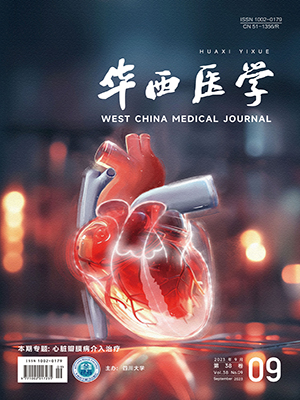【摘要】 目的 探討乳腺浸潤性導管癌中表皮鈣黏蛋白(E-cadherin,E-cad)的表達及其意義。 方法 選取2005年1月-2009年12月的組織病理切塊,用免疫組織化學EnVision二步法檢測63例乳腺浸潤性導管癌(invasive ductal carcinoma,IDC)組織中E-cad的表達情況,設為IDC組;另檢測15例乳腺纖維腺瘤及15例乳腺小葉增生癥乳腺組織中E-cad的表達情況,設為對照組;比較兩組的E-cad表達。 結果 E-cad在IDC組及對照組中表達陽性率分別為58.7%、80.0%;兩組間差異有統計學意義(P lt;0.05)。在乳腺IDC患者中,年齡 lt;38歲和≥38歲組的E-cad陽性表達率分別是54.2%、61.5%,兩組間差異無統計學意義(P gt;0.05);腫塊直徑 lt;3 cm和≥3 cm組的E-cad陽性表達率分別是54.8%、66.7%,兩組間差異無統計學意義(P gt;0.05);組織學分級為Ⅰ+Ⅱ級和Ⅲ級組的E-cad陽性表達率分別是76.3%、32.0%,兩組間差異有統計學意義(P lt;0.05);無、有腋窩淋巴結轉移組的E-cad陽性表達率分別是78.3%、47.5%,兩組間差異有統計學意義(P lt;0.05)。 結論 E-cad的表達與患者年齡及腫塊大小無關,而與組織學分級、淋巴結轉移相關。在乳腺浸潤性導管癌中,無淋巴結轉移者E-cad表達高于有淋巴結轉移者,提示E-cad是乳腺浸潤性導管癌發生淋巴結轉移的重要指標。
【Abstract】 Objective To explore the expression of the protein E-cadherin (E-cad) in invasive ductal carcinoma (IDC) of the breast and its significance. Methods We chose 63 cases of pathological wax with IDC between 2005 and 2009, and immunohistochemical EnVision method was used to detect the expression of E-cad protein in these cases which were designated to be the IDC group. At the same time, the E-cad expression in 15 cases of breast adenoma and another 15 cases of breast lobular hyperplasia were also detected, and these cases were designed to the the control group. The expression of E-cad in these two groups were compared. Results The positive rates of E-cad protein expression in the IDC group and the control group were respectively 58.7% and 80.0% with a significant difference between the two groups (P lt;0.05). In the IDC group, the positive rates of E-cad protein expression in patients aged lt;38 and ≥38 years old were respectively 54.2% and 61.5% without a significant difference (P gt;0.05). The positive rates of E-cad protein expression for tumors with a diameter lt;3 cm and ≥3 cm were respectively 54.8% and 66.7% without a significant difference (P gt;0.05). The positive rates of E-cad protein expression for class Ⅰ+Ⅱ tumors and class Ⅲ tumors were respectively 76.3% and 32.0% with a significant difference (P lt;0.05). The positive rates of E-cad protein expression for patients without and with axillary lymph node metastasis were respectively 78.3% and 47.5% with a significant difference (P lt;0.05). Conclusions The expression of E-cad is correlated with histological classification and lymph node metastasis and was not related to tumor size and age of the patients. The expression of E-cad is higher in IDC patients without lymph node metastasis than that in IDC patients with lymph node metastasis, which indicates that E-cad is an important index for lymph node metastasis of IDC.
引用本文: 劉桂桃,李霞. 乳腺浸潤性導管癌組織中表皮鈣黏蛋白的表達及其意義. 華西醫學, 2011, 26(7): 983-985. doi: 復制




